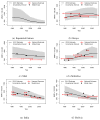A New Method for Deriving Global Estimates of Maternal Mortality
- PMID: 24416714
- PMCID: PMC3886639
- DOI: 10.1515/2151-7509.1038
A New Method for Deriving Global Estimates of Maternal Mortality
Abstract
Maternal mortality is widely regarded as a key indicator of population health and of social and economic development. Its levels and trends are monitored closely by the United Nations and others, inspired in part by the UN's Millennium Development Goals (MDGs), which call for a three-fourths reduction in the maternal mortality ratio between 1990 and 2015. Unfortunately, the empirical basis for such monitoring remains quite weak, requiring the use of statistical models to obtain estimates for most countries. In this paper we describe a new method for estimating global levels and trends in maternal mortality. For countries lacking adequate data for direct calculation of estimates, we employed a parametric model that separates maternal deaths related to HIV/AIDS from all others. For maternal deaths unrelated to HIV/AIDS, the model consists of a hierarchical linear regression with three predictors and variable intercepts for both countries and regions. The uncertainty of estimates was assessed by simulating the estimation process, accounting for variability both in the data and in other model inputs. The method was used to obtain the most recent set of UN estimates, published in September 2010. Here, we provide a concise description and explanation of the approach, including a new analysis of the components of variability reflected in the uncertainty intervals. Final estimates provide evidence of a more rapid decline in the global maternal mortality ratio than suggested by previous work, including another study published in April 2010. We compare findings from the two recent studies and discuss topics for further research to help resolve differences.
Keywords: AIDS mortality; Millennium Development Goals; maternal mortality; multilevel regression model.
Figures





References
-
- Abouzahr C. New estimates of maternal mortality and how to interpret them: choice or confusion? Reprod Health Matters. 2011;19(37):117–128. - PubMed
-
- Bates D, Maechler M, Bolker B. R package version 0.999375-42. 2011. lme4: Linear mixed-effects models using S4 classes.
-
- Cellule de Planification et de Statistique du Ministère de la Santé (CPS/MS), Direction Nationale de la Statistique et de l’Informatique (DNSI), and ORC Macro. Enquête Démographique et de Santé au Mali 2001. CPS/DNSI and ORC Macro; Calverton, Maryland, USA: 2002.
-
- Cellule de Planification et de Statistique du Ministère de la Santé (CPS/MS), Direction Nationale de la Statistique et de l’Informatique du Ministére de l’Économie, de l’Industrie et du Commerce (DNSI/MEIC), and Macro International Inc. Enquête Démographique et de Santé au Mali 2006. CPS/DNSI and Macro International Inc; Calverton, Maryland, USA: 2007.
Grants and funding
LinkOut - more resources
Full Text Sources
Miscellaneous
